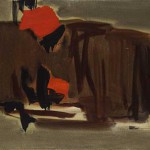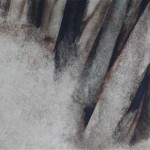The significance of Sohrab Sepehri in Iranian Modernism, especially during the period he worked on The Trees, is known to all. Much is said and written about it. These, however, can be looked at from a fresh perspective.
There are a lot of artists who have chosen to represent trees using a personal style. Abolghasem Saiedi, for instance, chose a metaphoric colorful style; Davoud Emdadian did that in an expressive way; Behjat Sadr and Farideh Lashai tried abstraction; and Hossein Mahjoubi exploited a personal romantic style to depict trees and landscape. What distinguishes the trees in Sepehri’s paintings from that of the other artists?
Sohrab was a well-known poet, both among the common people and intellectuals. Sohrab the painter, however, is even more prominent among the aficionados of the visual arts. It seems that a combination of the literary, poetic, and painterly skills of Sohrab as well as other individual characteristics, including his mystic lifestyle, early death, and astonishing affinity of his personality to his works, played a crucial role in introducing Sepehri as a uniquely skilled painter, and establishing his art market in recent years. The Trees often have huge dimensions. Rather than painting branches and leaves that was a more common practice in his time, Sepehri chose to depict the tree trunks as solid figures, often striving to consolidate his personal style, regardless of emerging movements in Iranian Modernism. It is said that “Sepehri took up painting at the time when Iranian visual arts was in chaos. Every individual artist endeavored to imitate an important artist and associate himself with a certain school of art.”[1] With a knowledge of the art of the world and a tendency to diverge from conventional movements, Sepehri, in fact, created an absolutely personal style of his own. The worldview of Sepehri, who is profoundly inspired by the art of the Far East, Zen, and Buddhism, is constantly moving toward the attainment of purity and spirituality. No place can be envisaged for these trees, neither do they belong to a specific time. It is even hard or impossible to imagine either end of this thick forest. It seems that Sepehri’s concepts are transferred onto the canvas through a sweet dream that can disappear any time. In a metaphoric sense, he did not paint, rather he composed his paintings. In other words, the tree trunk was an abstract minimalized form that would enable him to escape from a general idea to a detailed one. He saw trees as single words that produced a single picture once they united. The paint was not fluid; the fluidity was rather between the trunks and the surface. He puts several tree trunks together, as if in a collage, and repeated the same pulse that could go on forever. He would continue to paint the trunks up to the top margin of the canvas and emphasize the depth of the canvas through depiction of solid trunks.”[2]
From a different perspective, it is obvious that Sohrab’s painting is not directly connected to Impressionism. If we consider the indicators of Impressionism in literature, we may be able to offer a different new interpretation of his work. Impressionism in literature comes to embrace the moods, environmental effects, changing seasons, and quick passage of time. It expresses intangible transient sentiments and nondescript uncertain sensations. Everything will disappear in an instant; nothing will remain but a sense of effacement.[3] Contemplating in the trees that Sohrab painted, we realize that the impressionist spirit that is manifested literature is quite evident in his work. No one knows which land the trees belong to – trees that sometimes appear in the same color as the earth. They make the painted landscape appear as a passing moment of which only a fading sensation may remain; a sensation that resembles light. Perhaps there is a city facing the sun beyond these forests, like the city his poem reveals beyond the seas.[4]
The precision of Sohrab in setting up such a landscape and the concise composition that consists of a mere background and a few tree trunks is quite fascinating. This precision can be seen both in his art and poetry. Famous art critic, Karim Emami, commented on such qualities of Sohrab’s work, “Sepehri was precise and strict in his work. He would choose the best paper, canvas, and paint for his work. The frame of his canvas needed to be of the best quality, let alone the painting itself. He would refuse to exhibit his work if he had any doubt about the condition of the wor
[1] Ghareh Baghi, Ali Asghar, A Fresh Look at Paintings of Sohrab Sepehri, Human Sciences Magazine of the Alzahra University, winter 2008, vol. 74, p. 229
[2] Same: p. 11
[3] Yahaghi, Mohammad Jafar and Parsa, Shamsi; Impressionism in Sohrab Sepehri Poetry, Human Sciences Magazine, Alzahra University, Winter 2008, vol. 74, p. 229
[4] A Sohrab’s stanza says: There is a city beyond the seas / in which the sun is as vast as the eyes of the early risers.






